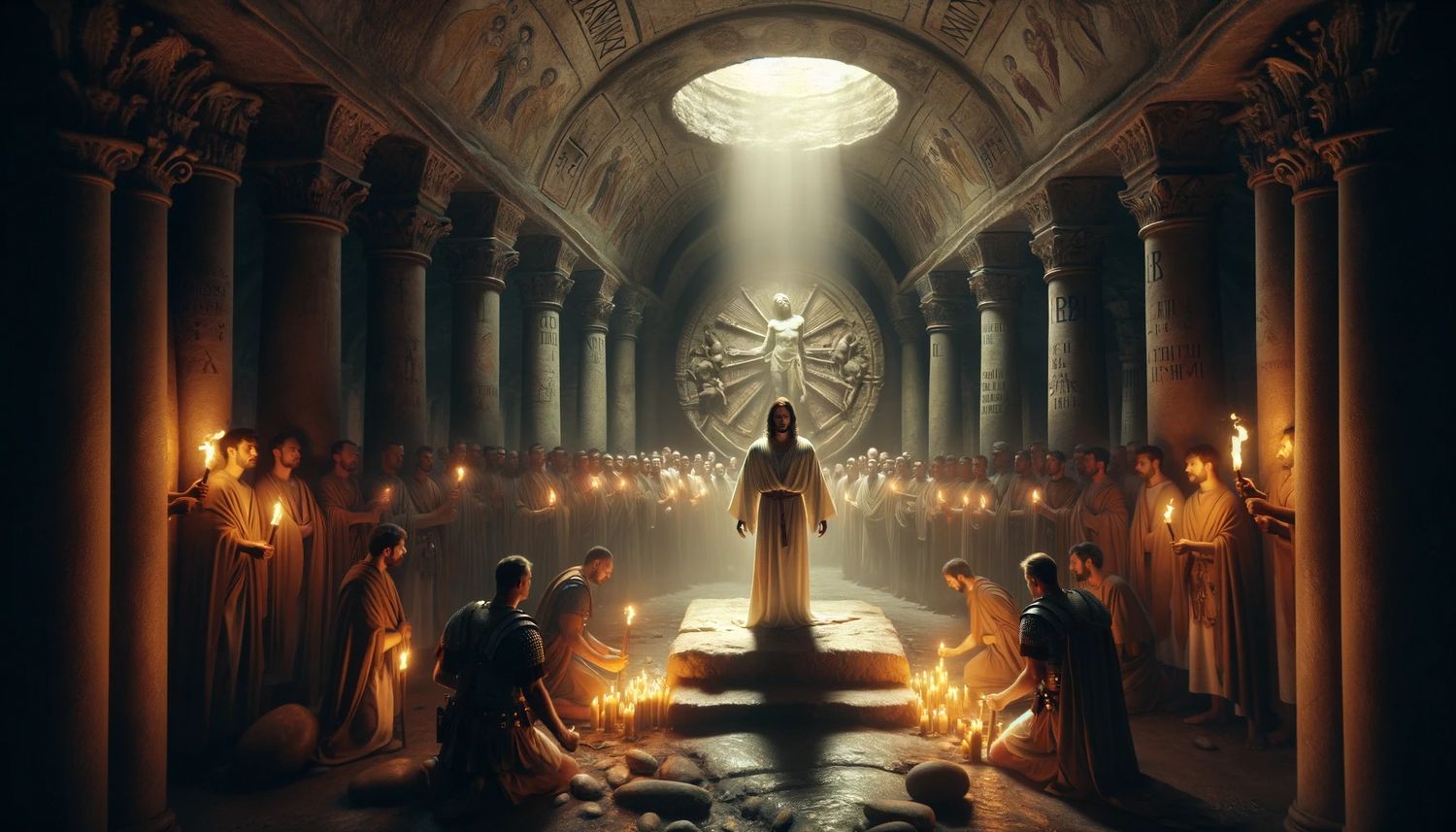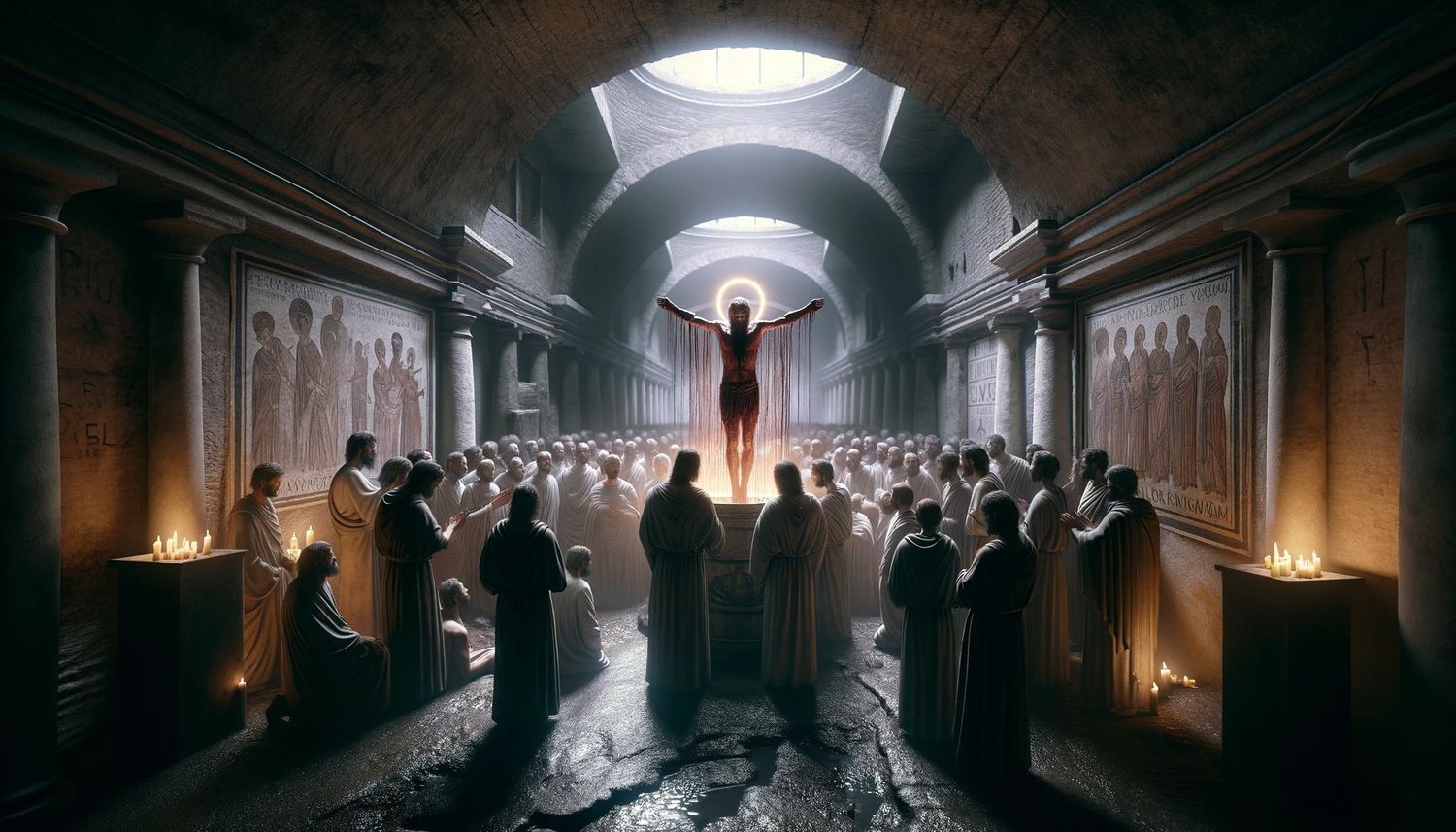Home>Theology and Spirituality>What Is A Baby Baptism


Theology and Spirituality
What Is A Baby Baptism
Published: March 2, 2024
Ericka Andersen, an editor at Christian.net, expertly merges digital strategy with content creation, focusing on faith and societal issues. Her communication skills enhance the platform's engaging narratives, fostering meaningful dialogue on belief's impact on society.
Learn about the significance and traditions of baby baptism in theology and spirituality. Discover the spiritual importance of this sacred ceremony.
(Many of the links in this article redirect to a specific reviewed product. Your purchase of these products through affiliate links helps to generate commission for Christian.net, at no extra cost. Learn more)
Table of Contents
The Significance of Baby Baptism
Baby baptism, also known as infant baptism, holds significant importance in many Christian traditions. It is a sacrament that symbolizes the cleansing of original sin and the initiation of the child into the Christian faith. The act of baptizing a baby is a profound ritual that carries deep spiritual meaning for both the child and the parents. It is believed to be a moment of grace and the beginning of the child's journey in the Christian community. Here are some key points that highlight the significance of baby baptism:
-
Cleansing of Original Sin: In many Christian denominations, baby baptism is seen as a way to cleanse the child of original sin, which is believed to be inherited from Adam and Eve. Through the sacrament of baptism, the child is welcomed into the faith and freed from the burden of original sin.
-
Initiation into the Christian Faith: Baby baptism serves as the child's initiation into the Christian faith and the church community. It marks the beginning of the child's spiritual journey and their inclusion in the body of Christ.
-
Receiving God's Grace: Baptism is seen as a means of receiving God's grace. It is a moment when the child is blessed and embraced by the love of God and the faith community.
-
Family and Community Celebration: Baby baptism is often a joyous occasion for the family and the church community. It is a time of celebration and thanksgiving as the child is welcomed into the faith with the support and prayers of loved ones.
-
Promise of Faith: Through baby baptism, parents and godparents make promises to raise the child in the Christian faith, teaching them the values and beliefs of Christianity. This commitment is an integral part of the significance of baby baptism.
-
Hope and Promise for the Future: Baby baptism represents hope and promise for the child's future. It is a declaration of faith in the child's spiritual journey and a commitment to nurture their relationship with God.
-
Symbol of New Life: Baptism is often seen as a symbol of new life in Christ. It represents the child's rebirth and the beginning of their walk with God.
The significance of baby baptism extends beyond the act itself, carrying deep spiritual and communal meaning for the child, the family, and the church. It is a sacred rite that embodies the beliefs and values of the Christian faith, marking the child's entry into a life of faith, love, and grace.
Read more: What To Write On A Baby Baptism Card
The History of Baby Baptism
-
Early Christian Practices: The history of baby baptism can be traced back to the early practices of the Christian church. In the first few centuries of Christianity, the baptism of infants was already a common practice. It was believed that the sacrament of baptism was essential for the salvation of the child, leading to the widespread acceptance of infant baptism within the Christian community.
-
Origins in Jewish Circumcision: The roots of baby baptism can also be linked to the Jewish tradition of circumcision. Just as male infants were circumcised as a sign of their inclusion in the covenant with God, early Christians saw baptism as the equivalent rite for both male and female infants, signifying their entry into the faith community.
-
Early Church Fathers' Support: The early Church Fathers, such as Origen and Augustine, provided theological support for the practice of infant baptism. They emphasized the importance of cleansing infants from original sin and incorporating them into the body of Christ through the sacrament of baptism.
-
Shift in Baptismal Practices: Over time, the mode and understanding of baptism evolved within the Christian church. While adult baptism by immersion was the predominant practice in the early church, the emphasis on infant baptism grew, leading to the development of specific liturgical rites and prayers for the baptism of infants.
-
Council of Carthage: The Council of Carthage in the 3rd century addressed the issue of infant baptism and affirmed its validity within the church. This council played a significant role in solidifying the practice of baptizing infants and provided theological clarity on the matter.
-
Medieval and Reformation Periods: Throughout the medieval and reformation periods, infant baptism remained a central sacrament in the life of the Christian church. While theological debates and variations in practice arose, the majority of Christian traditions continued to uphold the significance of baptizing infants as an essential part of their faith journey.
-
Contemporary Practice: In contemporary Christianity, the practice of baby baptism continues to be a significant and widely accepted sacrament in various denominations, including Catholic, Orthodox, Anglican, Lutheran, and others. The historical roots of infant baptism have shaped its significance and theological understanding within the diverse traditions of the Christian faith.
The history of baby baptism reflects the rich tapestry of Christian tradition, theology, and practice, illustrating the enduring significance of this sacrament in the life of the church and the spiritual journey of believers.
The Process of Baby Baptism
-
Preparation and Planning: The process of baby baptism typically begins with the parents or guardians making arrangements with their local church or religious community. They may meet with a clergy member to discuss the significance of baptism, the requirements for the ceremony, and the involvement of godparents. This initial stage involves thoughtful preparation and planning to ensure a meaningful and reverent baptismal experience for the child.
-
Selection of Godparents: In many Christian traditions, godparents play a significant role in the baptism of a child. The parents carefully select godparents, who are entrusted with the spiritual guidance and support of the child. Godparents are often chosen based on their commitment to the Christian faith and their willingness to nurture the child's spiritual growth. The involvement of godparents adds a communal dimension to the process of baby baptism, emphasizing the importance of spiritual mentorship and familial support.
-
Baptismal Ceremony: The actual baptismal ceremony is a central part of the process. It usually takes place during a church service, where the child, parents, godparents, and congregation gather to witness the sacrament. The clergy member presiding over the baptism may offer prayers, readings from the Scriptures, and a homily that underscores the significance of the sacrament. The child is then baptized with water, either through immersion, pouring, or sprinkling, accompanied by the recitation of traditional liturgical prayers.
-
Renewal of Baptismal Vows: In some Christian traditions, the parents and godparents reaffirm their own baptismal vows during the ceremony. This act serves as a reminder of their commitment to living out their faith and serving as spiritual guides for the child. The renewal of vows underscores the communal nature of baptism and the shared responsibility of nurturing the child's spiritual well-being within the Christian community.
-
Blessing and Anointing: Following the baptism, the clergy member may offer a blessing for the child and anoint them with holy oil as a symbol of their consecration and belonging to the Christian community. This act of blessing and anointing signifies the child's reception into the family of faith and their consecration to God's love and grace.
-
Celebration and Commemoration: After the baptismal ceremony, it is common for families to celebrate the occasion with a gathering or reception. This provides an opportunity for loved ones to come together, offer their congratulations, and share in the joy of the child's baptism. It is also a time to commemorate the significance of the sacrament and express gratitude for the child's initiation into the Christian faith.
The process of baby baptism encompasses a series of meaningful steps that reflect the spiritual, communal, and familial dimensions of the sacrament. From preparation and planning to the actual ceremony and post-baptismal celebration, each stage contributes to the profound significance of welcoming a child into the Christian faith through the sacrament of baptism.
The Role of Parents and Godparents in Baby Baptism
The role of parents and godparents in baby baptism is integral to the spiritual upbringing and support of the child within the Christian faith. Both parents and godparents play significant roles in the baptismal process, contributing to the child's initiation into the Christian community and their ongoing spiritual development.
Parents' Role
-
Commitment to Faith: The parents' decision to have their child baptized signifies their commitment to raising the child within the Christian faith. They are responsible for nurturing the child's spiritual growth, teaching them about the beliefs and values of Christianity, and fostering a supportive environment for their religious development.
-
Promises and Vows: During the baptismal ceremony, parents make solemn promises to raise the child in the Christian faith, guiding them in their spiritual journey, and providing a foundation of love, grace, and Christian values. These vows reflect the parents' dedication to instilling a strong Christian identity in their child.
-
Role as Spiritual Guides: As the primary caregivers, parents serve as the child's first and most influential spiritual guides. They are tasked with modeling a life of faith, demonstrating Christian virtues, and creating opportunities for the child to engage with the Christian community through regular worship, prayer, and participation in religious activities.
-
Support and Encouragement: Parents offer unwavering support and encouragement to the child as they grow in their understanding of the Christian faith. They provide a nurturing environment where the child can explore their spirituality, ask questions about their faith, and seek guidance on their journey of discipleship.
Read more: What If Baby Dies Before Baptism
Godparents' Role
-
Spiritual Mentorship: Godparents are chosen to serve as spiritual mentors and role models for the child. They play a vital role in supporting the parents in nurturing the child's faith and providing additional guidance and counsel as the child grows in their Christian identity.
-
Promises and Commitment: Godparents make promises during the baptismal ceremony, affirming their dedication to supporting the child's spiritual well-being, praying for them, and actively participating in their Christian upbringing. These commitments demonstrate the godparents' willingness to take on a significant role in the child's life.
-
Prayer and Guidance: Godparents are encouraged to pray for the child regularly and offer guidance and wisdom as the child navigates their faith journey. They may also share their own experiences of faith, offer spiritual counsel, and provide a loving presence in the child's life.
-
Lifelong Relationship: The role of godparents extends beyond the baptismal ceremony, as they are expected to maintain a lifelong relationship with the child, offering ongoing support, encouragement, and spiritual guidance as the child matures in their faith.
The combined efforts of parents and godparents create a nurturing and supportive environment for the child, ensuring that they are surrounded by love, faith, and guidance as they embark on their journey within the Christian community.
The Symbolism of Baby Baptism
-
Cleansing and Purification: The act of baptizing a baby symbolizes the cleansing and purification of the child from original sin. It represents the washing away of sin and the beginning of a new, spiritually pure life in Christ.
-
Incorporation into the Body of Christ: Baby baptism symbolizes the child's incorporation into the body of Christ, the community of believers. It signifies their belonging to the larger family of faith and their participation in the life of the church.
-
New Birth and Rebirth: Baptism is often seen as a symbol of new birth or rebirth in Christ. It represents the child's spiritual regeneration and the start of their journey as a follower of Jesus.
-
Sealing with the Holy Spirit: In many Christian traditions, baptism is associated with the sealing of the Holy Spirit upon the individual. For babies, this symbolizes the presence and guidance of the Holy Spirit in their lives from an early age.
-
Union with Christ's Death and Resurrection: The act of immersion in water during baptism symbolizes the believer's union with Christ's death and burial, and their emergence from the water symbolizes their participation in Christ's resurrection.
-
Clothing in Christ: Symbolically, baby baptism represents the child being clothed in Christ, signifying their identity as a member of the Christian community and their commitment to living a life in accordance with the teachings of Jesus.
-
Adoption into God's Family: Baptism symbolizes the child's adoption into God's family. It signifies their status as a beloved child of God and their inheritance of the blessings and promises of the Christian faith.
-
Initiation into the Priesthood of Believers: In some Christian traditions, baptism symbolizes the child's initiation into the priesthood of all believers, signifying their role as a participant in the ministry and mission of the church.
-
Eternal Life and Salvation: Baptism symbolizes the child's entry into the promise of eternal life and salvation through faith in Christ. It represents the hope of a future redeemed by God's grace.
-
Community and Communion: Baby baptism symbolizes the child's connection to the wider Christian community and their participation in the sacramental life of the church, including the sharing of the Eucharist or Holy Communion.
The symbolism of baby baptism encompasses a rich tapestry of spiritual meanings, reflecting the profound significance of the sacrament within the Christian tradition. It serves as a visible sign of God's grace, the child's belonging to the faith community, and their initiation into a life of discipleship and faith.
The Differences Between Baby Baptism and Adult Baptism
-
Age of Recipient: The most apparent difference between baby baptism and adult baptism is the age of the recipient. Baby baptism, as the name suggests, involves the baptism of infants or young children who are not yet able to make a conscious decision about their faith. On the other hand, adult baptism is administered to individuals who have reached an age where they can personally profess their faith and make a conscious decision to be baptized.
-
Understanding and Intent: In baby baptism, the child is not able to comprehend the significance of the sacrament or express a personal intent to be baptized. The decision to baptize a baby is typically made by the parents or guardians on behalf of the child, with the understanding that they will be raised within the Christian faith. In contrast, adult baptism involves a personal understanding of the Christian faith, a conscious decision to follow Christ, and a public declaration of one's commitment to the Christian beliefs and values.
-
Ceremonial Differences: The ceremonial aspects of baby baptism and adult baptism also differ. In baby baptism, the ceremony often involves the presence of parents, godparents, and the congregation, with an emphasis on the child's incorporation into the Christian community. Adult baptism ceremonies may include a period of instruction or preparation for the individual, a public profession of faith, and a more personalized expression of their spiritual journey.
-
Theological Implications: The theological implications of baby baptism and adult baptism vary within different Christian traditions. Baby baptism is often associated with the cleansing of original sin and the child's initiation into the Christian faith, while adult baptism is viewed as a conscious act of repentance, conversion, and commitment to Christ. The theological understanding of baptismal grace and its effects differs between the two forms of baptism.
-
Role of Godparents and Mentors: In baby baptism, godparents play a significant role in the child's spiritual upbringing and are entrusted with the responsibility of supporting the child's faith journey. In adult baptism, the emphasis may be on the individual's personal mentors, spiritual guides, or the role of the faith community in nurturing and supporting the newly baptized adult.
-
Personal Testimony and Witness: Adult baptism often involves the sharing of personal testimonies and life experiences that have led the individual to embrace the Christian faith. This aspect is not present in baby baptism, where the child's personal testimony and witness are yet to develop.
-
Understanding of Commitment: While baby baptism signifies the beginning of the child's journey in the Christian faith, adult baptism represents a conscious commitment to follow Christ, live out the Christian values, and actively participate in the life of the church. The understanding of commitment and discipleship differs between the two forms of baptism.
The differences between baby baptism and adult baptism reflect the diverse theological, ceremonial, and personal aspects of the sacrament within the Christian tradition. Each form of baptism carries its own significance and implications, tailored to the unique spiritual needs and experiences of the recipients.














